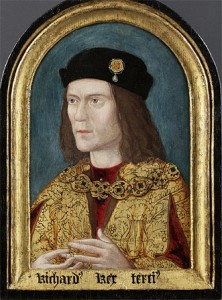
On the 22nd August 1485 Henry Tudors 5,000 Lancastrian soldiers met Richard III’s army of 8,000 at Bosworth in rural Leicestershire. Henry Tudor had been in exile in France during the reign of Edward IV but was now determined to depose Richard III and claim the throne for himself.
On 1st August 1485 Henry Tudor sailed from Harfleur in France to Milford Haven in Wales with a force of French mercenaries and English exiles. He landed on the Welsh coast on the 7th August and set about gathering further support and troops as he marched through Wales and the Welsh Marches, aiming for London. Henry also asked for support from his stepfather, Thomas Stanley, 1st Earl of Derby, who, although married to Henry’s mother, Margaret Beaufort, was a Yorkist supporter. Henry knew that his stepfather had money and influence and could rally his own private army. Stanley, and his brother William, did bring troops down from the North West of England, but we don’t know whether they committed to supporting Henry prior to the battle, they may well have wanted to keep their options open and we know that Richard, on hearing of Henry’s arrival, took Stanley’s son, Lord Strange, hostage to guarantee his support.
Richard III gathered his troops and marched from Leicester, aiming to cut off Henry who was marching from Wales to London. The two forces met in Leicestershire in a field near Stoke Golding, Sutton Cheney and Market Bosworth. The Bosworth Battlefield website tells of how the King’s army were on higher ground, with Henry’s forces “strung out in a line below” and that the Stanleys’ forces stayed out of the battle at first, while they decided on which side to support. The website tells the story:-
“Richard ordered his friend, the Duke of Norfolk, to attack Henry’s men, who were strung out in a long line after negotiating the marsh. Henry had never fought in battle before, but had the Earl of Oxford with him, an experienced soldier. Oxford placed two banners in the ground, and encouraged Henry’s men to form up between them. This created a solid wedge of men and when Norfolk charged, he found Oxfords Wedge difficult to attack. During the fierce fighting Norfolk was killed, however, the advantage of numbers was still with Richard and the Yorkists.

Henry decided to ride out with a small bodyguard to appeal to Lord Thomas, who was still uncommitted. Richard, from his higher vantage point, intended to stop Henry from reaching his step father. As the King and his Cavalry charged towards Henry, the force was so great that one of his Knight’s lances pierced through Henry’s standard bearer, and snapped in half.
At this point William Stanley finally committed to support Henry and his men attacked Richard and his Cavalry. Richard suddenly found himself outnumbered, and was cut down and killed.
Later that day, Richard’s crown was recovered and Henry was crowned on a nearby hill. Richard was buried at Grey Friars monastery in Leicester.
The Battle of Bosworth was the last major battle of the Wars of the Roses and Henry’s subsequent marriage to Elizabeth of York united the Houses of Lancaster and York and started a new house and dynasty, the House of Tudors. Thirty years of civil war was over.
But where did the Battle of Bosworth take place? Find out in my next post “The True Location of the Battle of Bosworth”.